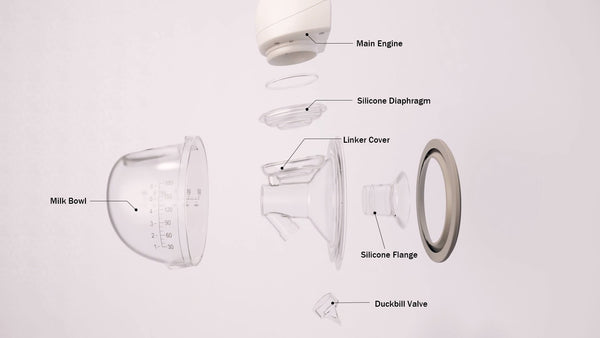I.IntroductionI.
Breast pumps are an indispensable tool for many mothers during breastfeeding, helping them to extract and preserve breast milk to provide nourishment for their babies. However, regular replacement parts and maintenance of breast pumps are vital to ensure their effectiveness and safety. We will delve into the importance of breast pump accessories and replacement parts to help you better understand and maintain your breast pump. If you are a new mom or an experienced mother, this article will provide you with practical advice and information that will make you feel more comfortable using your breast pump.
II.Overview of breast pump accessories

A breast pump is an important tool for breastfeeding mothers, and it consists of several key accessories, each of which plays an important role in ensuring an efficient and comfortable breast pumping process. Below is a detailed description of the key accessories of a breast pump:
Main Engine: The main engine is the core component of the breast pump, including the motor and control system, the main function is to generate suction and control the rhythm and strength of sucking milk. The quality and performance of the breast pump main engine directly affects the effect and experience of sucking milk.
Duckbill Valve: The Duckbill Valve is located inside the breast pump cups and its function is to prevent the backflow of milk, maintain the negative pressure inside the breast pump, and ensure the continuity and efficiency of sucking milk. It prevents backflow of milk, maintains suction power and prevents air from entering.
Linker Cover: The linker cover is used to connect the sippy cup to the main unit and is responsible for milk transfer. The design of the connecting tube should take into account the smooth flow of milk and be clean and easy to maintain. It should also ensure a tight seal to prevent air leakage.
Silicone Diaphragm: The silicone diaphragm is located inside the sippy cup and isolates milk and air to help create suction.
Milk Bowl: Milk bowls are used to collect milk and are usually scaled to measure the amount of milk, making it easy for the mother to control the amount of milk she draws each time. The design of the bottle makes it easy to pour or store the milk.
Silicone Flange: The flange is the part that comes into contact with the breast and is responsible for creating the seal that allows suction to effectively extract milk. Choosing the size of the flange is very important, a larger flange size will leak milk and a smaller size will cause pain in the nipple when suctioning, if you don't know how to choose the right flange for you, check out this article of ours that will help you to increase the efficiency and comfort of breastfeeding.
Apart from the above common accessories, there are some other accessories such as milk storage bags and bottles, which serve to facilitate the storage and preservation of milk and keep it fresh and hygienic.
III. Regular replacement of breast pump parts
Breast pumps are an important tool for breastfeeding mothers, but in order to maintain the performance and safety of the breast pump, the parts need to be replaced regularly. Below are the reasons why breast pump parts need to be replaced regularly, the life expectancy and recommended replacement frequency of each part, as well as the steps and precautions for replacing breast pump parts:
Why you need to replace breast pump parts regularly:
Maintaining breast pump performance and suction power: With increased use, breast pump parts can wear out or become deformed, affecting suction power and efficiency.
Avoid bacterial growth: Breast pump parts are prone to accumulating bacteria and dirt, and regular replacement reduces the risk of bacterial growth.
Provides a comfortable breast pumping experience: new breast pump parts ensure a tight seal and comfort for an improved breast pumping experience.
How often is it better to change breast pump parts
Host (Main Engine): The host generally does not need to be replaced often, but if there is a decline in performance or failure, it should be replaced or repaired in a timely manner.KISSBOBO provides customers with a one-year free warranty on the host, you can also add the purchase of a $1.99 annual warranty card, which will provide you with two years of warranty, but also provide you with 7/24 hours of customer service!
Duckbill Valve: Duckbill valve is recommended to be replaced every 3-6 months to avoid backflow of milk and to maintain suction.
Linker Cover: The linker cover generally does not need to be replaced often, but should be cleaned periodically to ensure a tight seal.
Silicone Diaphragm: Silicone diaphragms are recommended to be replaced every 3-6 months to maintain suction and prevent bacterial growth.
Milk Bowl: It is recommended that milk bottles be replaced every 3-6 months to ensure that the container is clean and hygienic.
Silicone Flange: Silicone flanges are recommended to be replaced every 3-6 months to maintain sealing and comfort.
When you buy KISSBOBO products we will attach two duckbill valves and flanges for you to replace in time, to protect the hygiene and health of baby and mom!
Steps and precautions for replacing breast pump parts:
Steps:
1. Select the appropriate parts for replacement according to the breast pump's instruction manual or the manufacturer's recommendations.
2. Make sure the breast pump is disconnected and cleaned and sterilized before replacing it.
3. Follow the correct procedure for replacing each part to ensure proper installation and good sealing.
Caveats:
1. After using new parts, test to make sure the suction power and effect are normal.
2. Regular replacement of breast pump parts maintains the performance and hygiene of the breast pump and ensures safe and comfortable breastfeeding. Therefore, mothers are advised to closely monitor the condition of 3. breast pump parts and replace them regularly as recommended.
IV. Breast pump maintenance and cleaning
Breast pump maintenance and cleaning is essential to maintain its performance and safety. Below is information on the importance of breast pump maintenance and cleaning, daily cleaning methods and precautions, and how to store your breast pump to ensure its long-term use:
The importance of maintaining your breast pump:
Maintaining breast pump performance and suction power: Regular maintenance ensures that your breast pump works properly and maintains suction power and efficiency.
Avoid bacterial growth: Cleaning and maintenance reduces the risk of bacterial growth and protects your baby's health.
Extended life: Regular maintenance will extend the life of your breast pump and save on replacement costs.
Daily cleaning methods and precautions for breast pumps:
Clean immediately after each use: Clean all parts of the breast pump with warm water and rinse thoroughly.
Regular Sterilization: Disassemble all the parts, except Main Engine, put the accessories into boiling water for 5 minutes, take out all the accessories, be sure to pay attention to wait for all of them to cool down completely before assembling them, in order to prevent the silicone accessories from thermal expansion and contraction.
Avoid immersion: Avoid prolonged immersion of breast pump parts in water to prevent deformation or damage.
TOTAL DRYING: Breast pump parts should be thoroughly dried after cleaning, either by gently drying with a paper towel or by air drying.
How to store breast pumps to ensure their long-term use:
Store in a dry and ventilated place: keep the breast pump in a well-ventilated and dry place to avoid moisture and bacteria growth.
Avoid direct sunlight: breast pumps should not be exposed to direct sunlight to prevent deformation or damage.
Separate storage: The parts of the breast pump should be stored separately to avoid crushing or damaging each other.
Regular maintenance and proper cleaning can ensure the long-term use of breast pumps and improve the efficiency and safety of breast pumping. Mothers should pay attention to the above maintenance and cleaning methods when using breast pumps to protect the health and safety of their babies.

V. Purchase and replacement of breast pump accessories
Purchasing the right breast pump accessories for your breast pump is key to ensuring that your breast pump operates properly and maintains breast pumping efficiency. Below are suggestions and considerations for purchasing the right breast pump accessories, as well as how to properly replace breast pump accessories and FAQs:
Suggestions and considerations for buying the right accessories for breast pumps:
Make sure it matches the breast pump model and brand: Breast pump accessories may not be compatible with different brands and models, so make sure the accessories match the breast pump before you buy.
Choose regular channels to buy: It is recommended to choose regular stores or official channels to buy accessories to ensure quality and performance.
Pay attention to the material and quality of the accessories: the material of the accessories should be safe and harmless, reliable quality, to avoid harming the baby.
How to properly replace breast pump accessories:
Disconnect the breast pump and disassemble the breast pump parts.
Follow the breast pump's instructions or the manufacturer's recommendations for proper installation of new accessories.
Ensure that the fittings are securely installed and well sealed to avoid air leakage and backflow of milk.
Frequently Asked Questions: Common problems and solutions for accessory purchases and replacements:
Problem: Purchased accessories do not match the breast pump.
Solution: Make sure the accessories match the breast pump before purchase to avoid unnecessary trouble.
Problem: Weak suction after parts replacement.
Solution: Check whether the fittings are installed correctly, check the Duckbill Valve, Silicone Diaphragm to ensure good sealing, if there is any problem, please replace the fittings in time.
Problem: Damaged or missing accessories.
Solution: Regularly check the condition of the accessories and replace damaged or lost accessories in time to ensure the normal operation of the breast pump.
Question: How do I store spare parts?
Solution: Store spare parts in a dry and ventilated area away from direct sunlight and moisture to ensure they are clean and safe.
VI. Conclusion
Breast pumps are an important tool for breastfeeding mothers, and the proper selection, use and maintenance of breast pump accessories are essential to ensure the effectiveness of breastfeeding and the health of your baby. In this article, we introduce the importance of breast pump parts, recommendations and steps for regular replacement, as well as methods and precautions for maintenance and cleaning. By replacing breast pump parts regularly, you can maintain the efficient performance and safety of your breast pump and avoid bacterial growth and milk contamination. Therefore, we emphasize the necessity of regular maintenance and replacement of breast pump parts.
When using a breast pump, mothers should regularly check the condition of their breast pump accessories and replace them as needed. We encourage readers to follow the advice and precautions provided in this article to ensure the effectiveness and safety of breast pumps and provide healthy breastfeeding for their babies.









